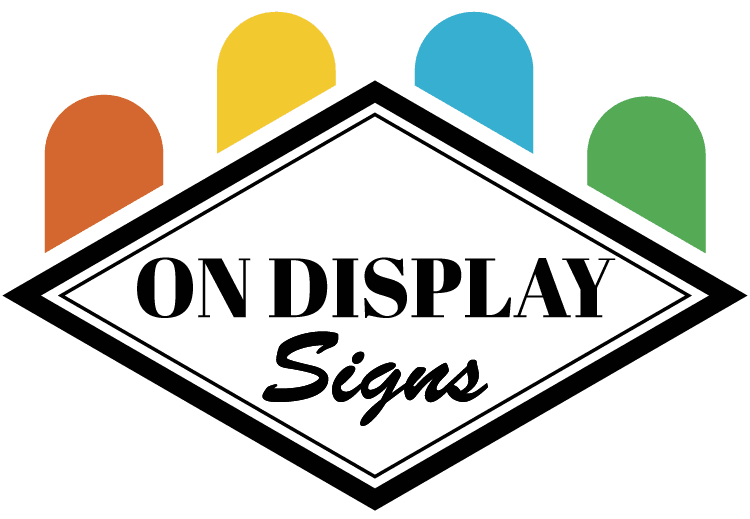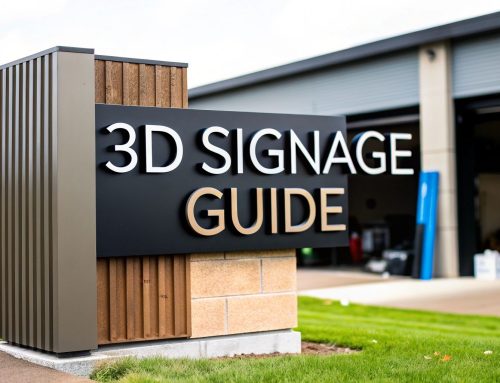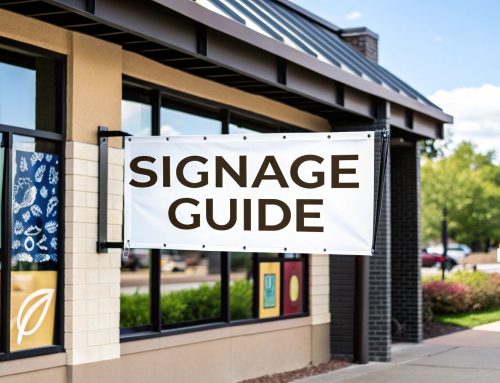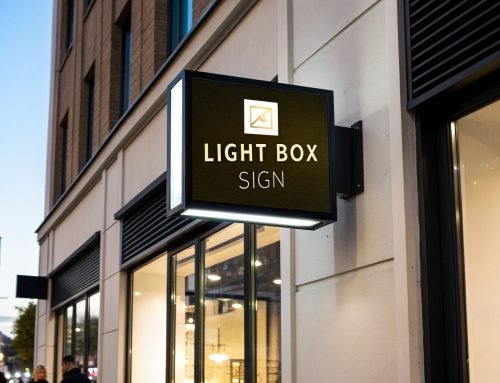When you move beyond a flat printed sign, 3D letters signage gives your brand a real, physical presence that’s impossible to ignore. A standard sign is like a photograph, but a 3D sign is more like a sculpture. It creates depth, plays with shadows, and gives off a feeling of permanence that people notice right away.
Why 3D Letters Make a Powerful First Impression
In a crowded marketplace, your storefront sign is the first handshake you offer a potential customer. It has to communicate professionalism, quality, and stability in a single glance. While a flat sign just conveys information, 3D letters signage tells a story and instantly builds your brand’s credibility.
The difference is huge. We all know how important making a strong first impression is online, and the same logic applies to your physical storefront. The solid, high-impact feel of dimensional lettering adds an architectural detail that immediately boosts the perceived value of your business. For instance, a dental clinic with polished metal 3D letters appears more established and trustworthy than one with a simple vinyl banner.
The Immediate Benefits of Dimensional Signs
The advantages go far beyond just looking good. A well-designed dimensional sign is a hardworking marketing tool that’s on the job for you 24/7, attracting and keeping customers.
Here’s what you get:
- Enhanced Visibility: The depth and shadow of 3D letters make them pop. They are far more noticeable from different angles and distances than any flat sign could ever be. A clothing boutique's sign with 4-inch deep letters will catch the eye of shoppers down the street, while a flat sign might be missed.
- Increased Professionalism: Dimensional signs have a premium look that tells people you’re a serious, established business, which helps build trust from the get-go. An accounting firm using brushed aluminum letters communicates stability and expertise.
- Brand Reinforcement: Turning your logo into a physical, three-dimensional object makes your brand more memorable and leaves a much stronger impact. A coffee shop's unique logo rendered in 3D becomes an unforgettable landmark.
"A sign is the face of your business. Dimensional signage gives that face character and depth, making it approachable and unforgettable."
This guide will walk you through everything you need to know to get from a simple idea to a stunning, traffic-driving sign. We’ll cover it all—materials, lighting, design, and more—so you can invest confidently in signage that truly makes your business stand out.
Choosing the Right Materials for Your Sign
Picking the right material for your 3D letters signage is a lot like choosing the foundation for a house. Get it right, and everything else falls into place. Get it wrong, and you could be facing problems down the road. This decision single-handedly dictates your sign's final look, how long it will last, and what it's going to cost.
The material you go with needs to be a perfect match for your brand’s personality, the sign's location, and your budget. A sleek, polished metal sends a completely different message than a vibrant, colorful acrylic. One says "strength and permanence," while the other says "modern and approachable." It's all about understanding what each option brings to the table.
This is how a well-thought-out sign builds real value for your business.
As you can see, it's about more than just looking good. It's about turning a physical object into a hard-working marketing asset.
Durable and Premium Metals
When you need a sign that screams quality and is built to last, nothing beats metal. Aluminum is the go-to choice for exterior 3D letters signage for one simple reason: it stands up to harsh weather. It won't rust or corrode, and while it's incredibly strong, it’s also surprisingly lightweight, making it perfect for large-scale building signs.
Think about a high-end law firm or a boutique hotel. Brushed aluminum letters with subtle halo lighting project an image of sophistication and trust before a client even opens the door. While metals are a bigger upfront investment, their sheer durability makes them a smart long-term play. They require next to no maintenance and can look fantastic for decades. You can see some great examples in our guide to stunning aluminium composite signage.
Versatile and Vibrant Acrylic
If your goal is to make your brand colors leap off the wall with a clean, modern pop, acrylic is your best friend. It comes in a massive range of colors and can even be printed with custom graphics, giving you incredible creative freedom. Its naturally glossy surface delivers a polished look that’s a perfect fit for retail shops, tech startups, and medical offices.
But acrylic’s real superpower is its relationship with light. It’s the industry standard for front-lit channel letters because it diffuses light so evenly, making the entire face of the letter glow. Imagine a trendy clothing store with bright pink acrylic letters that are impossible to miss, day or night. That’s the kind of show-stopping power this material offers.
Cost-Effective and Lightweight Options
For businesses focused on making a big impact indoors without a massive budget, materials like PVC and foam are fantastic workhorses. PVC (Polyvinyl chloride) is a tough plastic that's easy to work with and can be painted any color under the sun. It’s a solid, professional-looking choice for lobby signs or directional signage in an office building.
Foam, which is often finished with a thin layer of acrylic or metal for a more premium feel, is ridiculously lightweight. This makes it the ideal solution for large logos in a reception area or for trade show displays where you need something big and impressive that won't pull the wall down.
To help you decide, here’s a quick breakdown of how these popular materials stack up against each other.
Comparing Common 3D Signage Materials
| Material | Best For | Durability | Typical Cost |
|---|---|---|---|
| Aluminum | High-end exterior signs, professional services | Excellent (weather & rust resistant) | $$$ |
| Acrylic | Illuminated signs, vibrant branding, retail | Very Good (UV resistant) | $$ |
| PVC | Interior logos, directional signs | Good (durable but for indoor/sheltered use) | $ |
| Foam w/ Face | Large indoor displays, trade shows | Moderate (lightweight but less impact resistant) | $ |
Ultimately, the best material is the one that tells your brand’s story most effectively while standing up to the environment where it will live.
How Fabrication and Lighting Bring Your Sign to Life
Once you’ve locked in the perfect material, the real magic begins. This is where skilled fabrication and smart lighting turn a digital design into a tangible, eye-catching piece of 3d letters signage. How your sign is built is just as critical as what it's made of—it determines its final structure, durability, and how it performs after the sun goes down.
Think of fabrication as the sculpting process. Two main techniques rule the industry, and the choice between them really comes down to one question: will your sign be lit from the inside?
The first method is CNC routing, the go-to for solid, non-illuminated dimensional letters. A computer-guided router precisely carves each letter from a single sheet of material like aluminum, acrylic, or PVC. The result is letters with crisp, perfect edges that rely on natural light and shadows to create their dimensional pop.
Crafting Letters for Illumination
But when you need your sign to shine bright at night, the process changes completely. This is where channel letter construction comes in. It’s the standard for creating hollow letters designed specifically to hold internal lighting.
Instead of carving from a solid block, artisans construct each letter from three key parts:
- The Face: Usually a translucent piece of acrylic that lets the light shine through.
- The Return: The side of the letter, typically made from aluminum, which gives the letter its depth.
- The Back: An aluminum piece that seals the letter and acts as the mounting surface.
This method creates a “channel” inside each letter, making the perfect home for modern, efficient LED modules.
Lighting That Defines Your Brand's Personality
Illumination gives your 3d letters signage its after-dark character. The lighting technique you choose directly impacts how customers see your brand at night, transforming your sign from a simple daytime marker into a 24/7 beacon. There are two primary styles, each with its own distinct vibe.
First, you have the classic front-lit style. With this approach, LEDs placed inside the channel letters shine forward through the acrylic face, making the entire letter glow. This delivers maximum visibility and is the most popular choice for retail stores, restaurants, and any business that needs to grab attention on a busy street. It’s bold, direct, and impossible to miss. To learn more, check out our insights on how LEDs can power up your digital signage.
The alternative is the sophisticated halo-lit (or "reverse-lit") style. Here, the letter's face is solid metal, and the light is aimed backward onto the wall. This creates a soft, elegant glow or "halo" effect around each letter, a popular choice for professional services, upscale boutiques, and brands looking for a more high-end, understated feel.
A halo-lit sign doesn't shout; it whispers. This subtle approach can create an exclusive and premium atmosphere that draws customers in with its understated confidence.
These lighting techniques offer practical advantages. A pizza parlor on a main road would benefit from bright, front-lit letters to attract hungry drivers, whereas a high-end spa might choose the soft glow of halo-lit letters to create a serene and exclusive ambiance at its entrance.
Key Design Principles for Maximum Impact
An expertly fabricated sign is only half the battle; its design determines whether it gets noticed or just blends into the background. When it comes to 3d letters signage, effective design isn't about overly complex art. It’s about clear, powerful communication that grabs attention from the moment someone lays eyes on it.
Think of your sign's design as its voice. A whisper-thin, ornate font might look beautiful up close, but from across a busy street, it becomes an indecipherable mumble. The goal is to create a clear, confident voice that carries and speaks directly to your potential customers.
Typography: The Foundation of Readability
The font you choose is the single most important decision for legibility. While elaborate serif fonts have their place, their small "feet" and varying line thicknesses often blur together when viewed from a distance, especially when rendered in three dimensions.
For most exterior applications, bold sans-serif fonts are the undisputed champions. Their clean, uniform lines make every letter crisp and distinct, even to someone driving past at 35 mph. This is all about function over flair—a sign that can't be read is just an expensive decoration. Getting the style right is crucial, and you can see what works well in 3D in our guide on the best fonts for metal signs.
Sizing Your Letters for Optimal Viewing
Size matters. A lot. An undersized sign is a wasted opportunity, completely invisible to the very people you want to attract. The good news is that there’s a straightforward way to get it right: design for the intended viewing distance.
A simple rule of thumb is that for every 10 feet of viewing distance, your letters should have at least one inch of height.
This means if you need your sign to be legible from a road 100 feet away, your letters have to be at least 10 inches tall. Here’s a quick breakdown:
- Sidewalk Pedestrians (20-30 ft): Letters should be a minimum of 2-3 inches tall.
- Local Street Traffic (100 ft): Aim for letters that are at least 10 inches tall.
- Major Road or Highway (400+ ft): Letters need to be 40 inches tall or more.
Always think about the furthest point a customer might see your sign from and size your letters for that distance. It’s always better to be a little too big than even slightly too small.
Color and Contrast: The Keys to Visibility
Your sign doesn’t exist in a bubble; it lives on a building, and its effectiveness hinges on how well it stands out against that backdrop. This is where color and contrast are non-negotiable. A sign with poor contrast simply melts into its surroundings, defeating its entire purpose.
To make sure your 3d letters signage pops, you need strong contrast between the letters and the surface they're mounted on. Think dark letters on a light-colored wall or bright letters against a dark brick facade. For a practical test, print your design in black and white. If the letters are still clear and easy to read, you have strong contrast. This isn't just about looks—it's about the science of visibility. High-contrast combinations ensure your sign is readable in all kinds of lighting, from the harsh glare of noon to the dim light of a cloudy day.
Understanding the Installation Process
Once the design is locked in and your letters are perfectly fabricated, the last step is getting them up on the wall. This is where a professional installation process for your 3d letters signage isn't just important—it's everything. A perfect installation makes sure your sign is secure, durable, and positioned just right to grab attention and make your brand look its best.
Think of it like building a high-performance engine; you can have the best parts in the world, but if they aren't assembled with absolute precision, the whole thing fails. Small mistakes during installation can cause huge headaches later, from a sign that’s slightly crooked to one that’s a genuine safety hazard. That’s why the real work starts long before the installation crew ever shows up.
The Critical First Steps: Site Survey and Permitting
Before a single hole gets drilled, two things have to happen: a site survey and permit acquisition. A professional site survey is non-negotiable. This is when installers come out to examine the mounting surface, checking the wall’s material—is it brick, drywall, or stucco?—and looking for hidden obstacles like wiring or plumbing. This lets them figure out the exact hardware needed for a rock-solid fit.
Next up is securing the right local permits. Most cities and towns have strict rules about the size, placement, and type of signs you can put on a building. Trying to skip this step can lead to big fines and an order to take the sign down. It pays to understand the local regulations, and you can get a better handle on the ins and outs of sign permit requirements in our detailed guide.
A professional sign company handles the entire permitting process for you, from submitting applications with engineering drawings to dealing with final inspections. This service alone will save you a ton of time and prevent major headaches.
This prep work is what makes the actual installation day go off without a hitch. No surprises, no last-minute problems.
Common Mounting Techniques Explained
How your 3d letters signage is attached to the wall has a massive impact on its final look. There are two main methods, and each one creates a completely different feel.
The most common approach is flush mounting, where the letters are fixed directly onto the wall. This gives you a clean, integrated look, almost like the letters are a natural part of the building itself. It's a simple, popular choice for both interior and exterior signs when you want a sleek, seamless appearance. For example, a corporate logo flush-mounted in a lobby looks sharp and professional.
The other option is standoff mounting, which uses small metal spacers to lift the letters off the surface. This creates a cool "floating" effect, adding real depth and casting soft shadows that shift as the sun moves. Standoffs are also a must for halo-lit signs, as they create the space needed for the light to spill out from behind and produce that signature glow. A high-end salon might use standoff mounting to give their sign a more luxurious feel.
Budgeting for and Maintaining Your Signage Investment
Deciding to invest in high-quality 3d letters signage is a big move for any business, and getting a handle on the costs is the first step. The final price isn't just a single number; it's a blend of different factors that all contribute to the bottom line. Thinking these through upfront helps you nail down a realistic budget and avoid any sticker shock later on.
The single biggest cost driver is almost always the material you choose. As we've covered, premium metals like aluminum command a higher price but pay you back in durability, while options like PVC or faced foam deliver a sharp, professional look on a tighter budget. That one choice sets the stage for the rest of your costs.
Key Factors That Influence Your Sign's Cost
Beyond the raw materials, a few other key variables will shape the final price tag. Each one adds a layer of complexity, labor, or technology to the project, which naturally affects the cost.
- Overall Size: This one's pretty simple—bigger signs need more material and more time to build and install. A massive sign destined for a warehouse facade is going to have a different price point than a tasteful sign for a small retail shop.
- Design Complexity: A clean, simple font is much easier to fabricate than a swirling, intricate script or a detailed logo with tiny pieces. The more complex your design, the more precision and time it takes to get it right.
- Lighting Options: Adding illumination is one of the best ways to get noticed, but it definitely adds to the cost. Internally lit channel letters, for example, are more of an investment than non-illuminated dimensional letters because of the electrical components and specialized build.
When you're looking at the total cost of your 3d letters signage, it's smart to see what your payment options are. Many sign companies offer financing, and you can also explore resources like equipment financing specifically designed for small businesses to make the investment more manageable.
Protecting Your Investment with Simple Maintenance
Once your sign is up, a little bit of care goes a long, long way in protecting your investment and keeping it looking sharp for years. A dirty sign or one with burnt-out lights just sends the wrong message to potential customers. The good news? The upkeep is usually pretty straightforward.
A clean, well-maintained sign shows that you care about the details of your business. This simple act of upkeep reinforces the professionalism and quality that your 3D signage was designed to communicate in the first place.
A basic maintenance routine is all it takes to stop small problems from turning into big, expensive repairs.
Your Actionable Maintenance Checklist
Just follow these simple steps to make sure your 3d letters signage stays a powerful and vibrant asset for your brand.
- Perform Regular Cleaning: At least twice a year, give the letters a gentle cleaning. For most materials like acrylic or metal, a soft cloth with a bit of mild soap and water is all you need to wipe away the dust, grime, and pollen that can make your sign look dull.
- Inspect Electrical Components: If your sign is lit, take a look at it at night every so often to check for flickering or dead LEDs. During the day, glance over the wiring to make sure nothing looks loose or exposed. Catching these things early can save you a headache.
- Check for Physical Damage: After a big storm or heavy winds, it’s a good idea to give your sign a quick visual check. Look for any letters that might be loose or any dings and scratches on the surface. A secure sign is a safe sign.
By budgeting with a clear head and sticking to a simple maintenance schedule, you can ensure your sign keeps working hard for your business and representing your brand perfectly for its entire lifespan.
Common Questions About 3D Letter Signage
When you're investing in your brand's physical identity, you’re bound to have some questions. It’s a big decision. Here are some straightforward answers to the things business owners ask us most about 3D letter signage.
How Long Does 3D Letter Signage Typically Last?
How long your sign lasts comes down to two things: the material it’s made from and the environment it’s in. For an outdoor sign that needs to face the elements, high-quality aluminum is the undisputed champion, easily lasting over 10-15 years with minimal upkeep. It’s built to withstand rough weather without a hint of rust or fading.
Other materials hold up incredibly well, too. You can expect a solid 7-10 years of outdoor performance from acrylic and PVC. Bring any of these materials indoors, away from sun and rain, and they can last practically forever, making them a one-time investment that pays off for decades.
What Is the Difference Between Channel and Dimensional Letters?
This is a common question, but the difference is actually pretty simple. Think of "dimensional letters" as a catch-all term for any solid, 3D letter that isn't lit from the inside. It’s a solid piece of metal, acrylic, or plastic mounted on a wall.
"Channel letters," on the other hand, are a specific type of dimensional letter. They are built to be hollow on the inside—they have a "channel"—specifically to house lighting like LEDs. So, all channel letters are dimensional, but you only need to ask for channel letters if you want your sign to glow.
Can My Existing Logo Be Turned into a 3D Sign?
Almost always, yes. The vast majority of logos translate beautifully into 3D letter signage. The only time we might need to make small tweaks is if a design has extremely fine lines, a very delicate script font, or complex color gradients that are tricky to replicate physically.
A good sign designer can look at your vector logo file and recommend minor adjustments that keep your branding intact while ensuring the finished sign is sturdy, durable, and looks fantastic from every angle.
The goal is never to change your brand, but to optimize its design for the physical world, ensuring it remains impactful and legible from every angle.
How Visible Are Non-Illuminated Signs at Night?
By themselves, non-illuminated signs won't be visible in the dark. Their beauty comes from the way sunlight and ambient light create shadows and depth during the day. But that doesn't mean your brand has to disappear after sunset.
You can get fantastic nighttime visibility without the expense of internal illumination. By strategically aiming external lights—like goose-neck lamps, spotlights, or wall washers—at your sign, you can create a dramatic, high-end look. It’s a cost-effective way to make sure your business stays visible 24/7.
Ready to bring your brand to life with stunning 3D letters? The experts at On Display Signs, Inc. manage every detail, from design to installation, ensuring a flawless result that gets you noticed. Start your signage project today.




